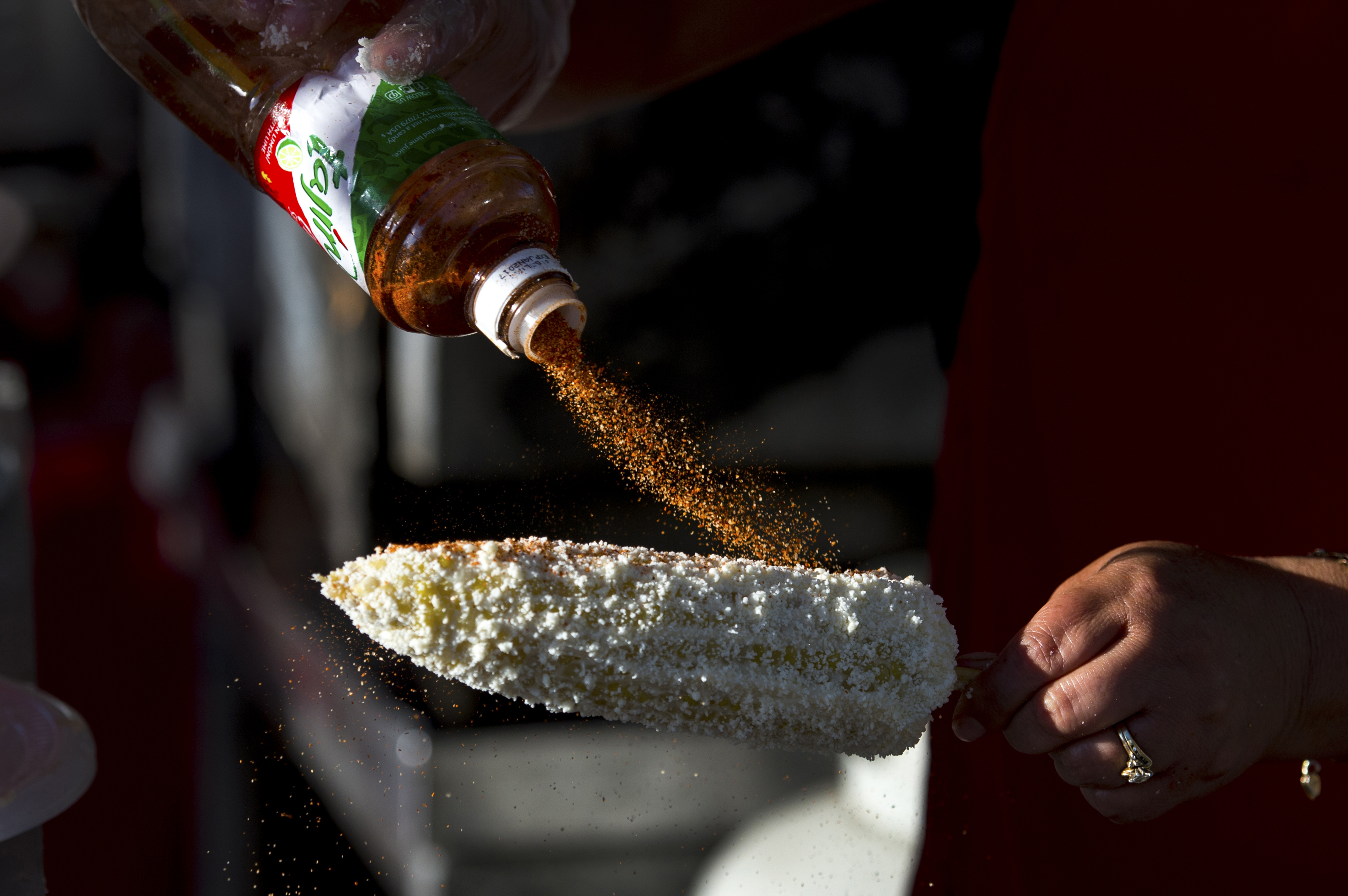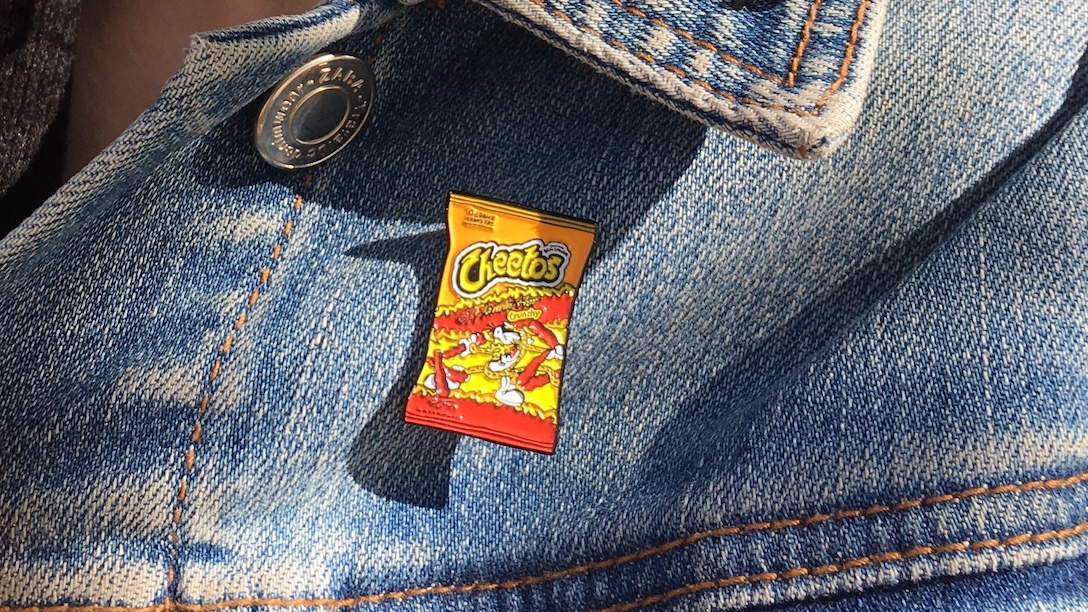In my elementary school cafeteria, the boys were known for playing a game with Flamin’ Hot Cheetos. One would open up a snack-size bag and put a Cheeto in his mouth. He did not chew, but instead left it resting on his tongue. He’d pass the bag to a kid next to him, who did the same. Soon the bag was circling the table, each student placing another Cheeto into his mouth until the bag was empty or—and this usually came first—the burning sensation from the Flamin’ Hot powder became so intense he’d slap the table, crunch down, and dive for his carton of milk.
It took hundreds of bags of Flamin’ Hots, Takis, and Lucas lollipops dipped in their accompanying sweetened cayenne powder to build the kind of iron stomach that could crown a boy our lunchtime champion. These snacks are so spicy that they can allegedly erode your stomach lining or aggravate ulcers. The hot powder doesn’t lose its potency or coloration during digestion, either, so you might get rushed to the hospital after spending an agonizing evening on the toilet. Just recently, the rapper Lil’ Xan blamed his love for Flamin’ Hots for his trip to the emergency room. Today, the boys from my elementary school would call him a legend.
Flamin’ Hot Cheetos were invented by Richard Montañez, the son of Mexican immigrants. He was a janitor at a Frito-Lay factory in California when he came up with his multimillion dollar idea. He noticed that the company didn’t make any spicy products, so he conducted an experiment. He created a blend of spices based on the coating of elotes—corn smothered with chili powder, mayonnaise or sour cream, and cheese—a street food he loved since childhood.

Montañez covered some dust-free Cheetos with his homemade seasoning, miraculously caught Frito-Lay’s CEO’s attention, and the rest is history. Due to his ingenuity, Montañez was eventually promoted to PepsiCo North America’s vice president. His rags-to-riches story is so wholesome, Fox Searchlight is making a film about his life.
The first time I tried a Flamin’ Hot Cheeto, I was thrown into a coughing fit, reeling from its unexpected dustiness and spice. Then I stuck my whole hand in the bag and put a fistful in my mouth.
I grew up in a diverse, lower middle-class Chicago suburb in a conservative Jewish family. Though my parents are second-generation Americans who, in an effort to fully assimilate to American culture, were never taught Yiddish, many of my neighbors were new to the States. In addition to English, the cliques in my school spoke Spanish, Ukrainian, Polish or Russian; and when my parents drove down Milwaukee Avenue on our way to temple, I’d see an abogado (lawyer) and a булочная (bakery) on the same block as a combination Taco Bell and KFC. Corner stores carried large selections of imported snacks, and typically placed Flamin’ Hots right next to their impulse-buy register treats—spicy tamarind straws and roasted sunflower seeds with Cyrillic labels I could not read.
Flamin’ Hots appealed to those with precarious food security—immigrants and poor kids—who didn’t know if they’d hit the FDA’s recommended calorie count for the day. While Flamin’ Hots lack nutritional value—so much so that they’ve been banned in some school cafeterias—the 3.25 ounce snack-sized bag contains more than 500 calories, which makes a nice dent in that daily intake for under two dollars.
So I was surprised to learn Flamin’ Hots were being reinvented into haute cuisine, at celebrity chef Roy Choi’s Flamin’ Hot Cheeto pop-up restaurant. Choi himself comes from a modest background and grew up chomping on Flamin’ Hots in South Los Angeles, so he has as much of a claim to it as anyone. But I worried diners may have lost sight of their humble beginnings. While Flamin’ Hots may have become an Instagrammable trend, most creative uses of it as an ingredient have nothing to do with “foodies.”
Since their flavor is drawn from Mexican snacks, it’s not surprising that Flamin’ Hots’ have an especially devout cult following in border towns like those near Tijuana and Ciudad Juárez. Once the inspiration for the product, street vendors now use Flamin’ Hots as the basis for their own experiments. You can find them smothered with cheese, lime and even more chili powder, served in their bag like a Frito Pie; sushi rolls coated in the Flamin’ Hot dust; nuclear red raspas. They’ve even come full circle, with elotes rolled in Flamin’ Hots powder rather than the traditional chili powder.
Here’s one way to make a jailhouse burrito: barter for some ramen noodles, two bags of Flamin’ Hot Cheetos, Doritos, and/or Lays, a beef stick and, if you have a hookup in the kitchen, a fresh pickle or onion. Crush up the ramen and chips until they’re pulverized. Dice the Slim Jim, pickle, and onion into small pieces with a shiv. Add all these ingredients back into your empty bag of chips and shake it up to blend thoroughly. Add one to one and a half cups of hot water—it doesn’t need to be boiling—and roll up the bag in a burrito-shape. Wrap it in a towel or hide it under a mattress for about 10 minutes. After it’s fully cooked, slice the bag open and dig into your spicy, 3,000 calorie creation.
That’s just one of many improvised dishes inmates have concocted to add flavor and nutrition to their diets. In a paper for Gastronomica: The Journal of Food and Culture, Sandra Cate learned through interviews that prison inmates often face food fatigue, due to cafeterias serving bland and repetitive meals. Many are concerned that portion sizes are too small, rarely satisfying their appetites. Prisoners also disproportionately experience foodborne illnesses, due to lack of oversight. They’re served food that’s molding, infested with maggots, or nibbled by rodents.
Highly processed Cheetos, for all their nutritional drawbacks, are a less risky option than tainted prison food. Prisoners can only obtain snacks two ways: by smuggling them from the cafeteria and purchasing snacks from their commissary. But there are often limits on how much a prisoner can spend in a week, so Flamin’ Hot Cheetos, which are cheap, salty and pack a lot of flavor, have become a staple ingredient in jailhouse burritos, spread, and chi chi.
Now those prison delicacies, too, are making their way into mainstream culture. Back in Los Angeles, Fatima’s Grill owner and chef Ali Ereda, draws from his experience of incarceration chef in the Federal Correctional Institution, Safford. He offers an alternative to Roy Choi’s upscale dining with his humble prison-inspired halal dishes infused with Flamin’ Hot Cheetos.
My parents raised me with extraordinary leniency when it came to eating processed foods. After my mother came home from work, where she had spent the day serving rowdy middle schoolers or blood donors in busy cafeterias, the last thing she wanted to do was come home and make food from scratch. So we often took trips to McDonald’s and Burger King, and when cooking at home, my mother diligently followed the instructions on ready-made foods that came in boxes, cans, and frozen bags.
But she did have one rule about junk food: it couldn’t turn your teeth, tongue or fingertips another color. That meant Flamin’ Hots were forbidden, which made them all the more appealing. Like most junk food, the snack is already chemically designed to be addictive. Flamin’ Hots reach the salty, fatty food “bliss point,” which is what food science calls the ideal balance of flavor that tricks your brain into depressing your appetite and leaves you craving more. Add in a splash of adolescent rebellion, and I was hooked.

While I’m not normally one for nostalgia, Flamin’ Hot Cheetos never fail to remind me of where I come from. They’re a mass marketed, processed food—the opposite of a traditional culture. But people with limited means have transformed them. In their hands, Flamin’ Hots can become a way to fuse traditional cuisine with the flavors of an adopted country, or a colorful reminder of life outside of confinement.
Over time, my cultural landscape changed. My family moved to a Jewish, mostly white suburb, and I earned a scholarship and went to a private university with much wealthier classmates. Several years later, I’m working on a masters degree and training to become a curator. The galleries and seminar rooms I now find myself inhabiting are a far cry from the corner stores of Milwaukee Avenue. But I can’t help continuing to break my mother’s rule. On the pages of my books or the surface of my desk, I still leave red fingerprints.
Renée Lynn Reizman






